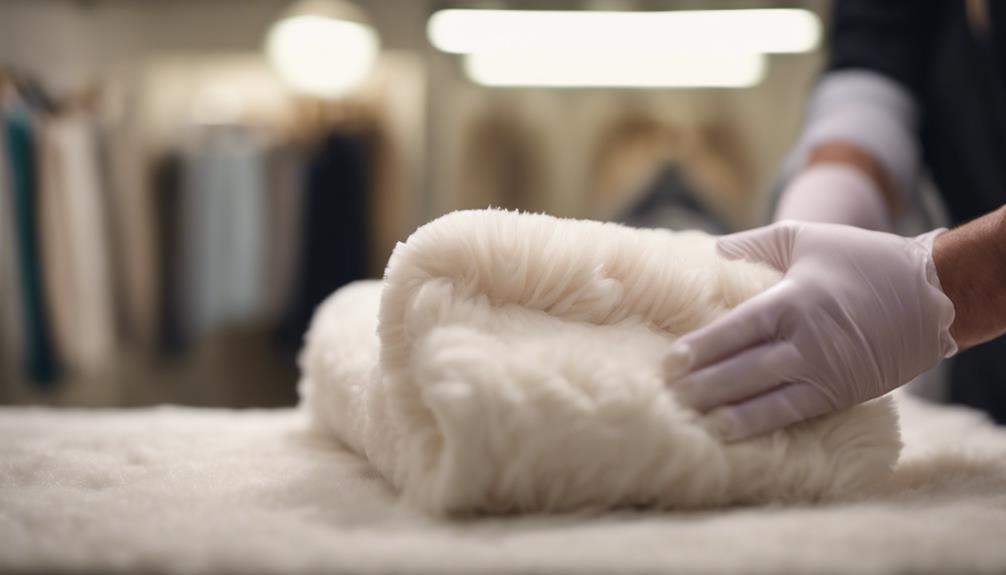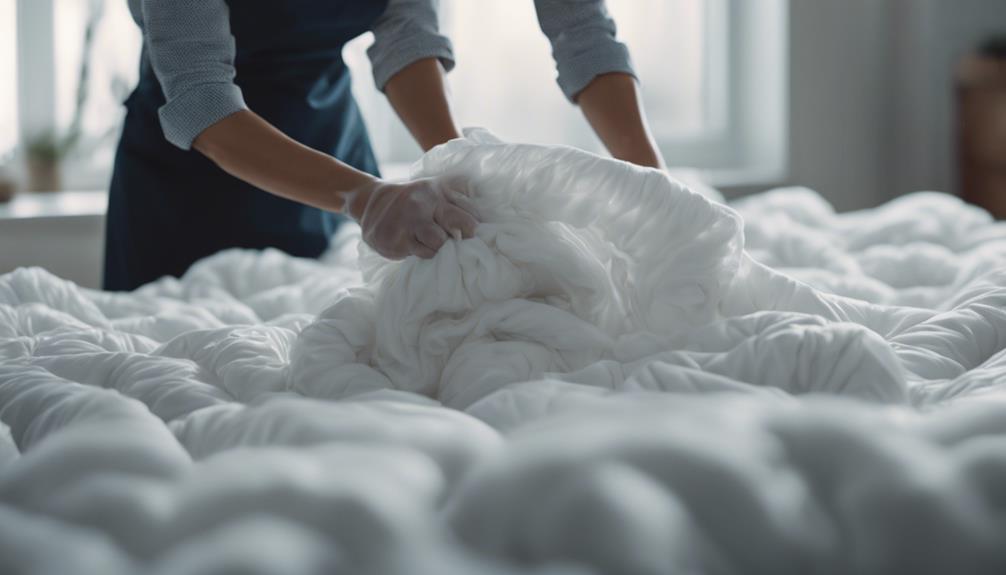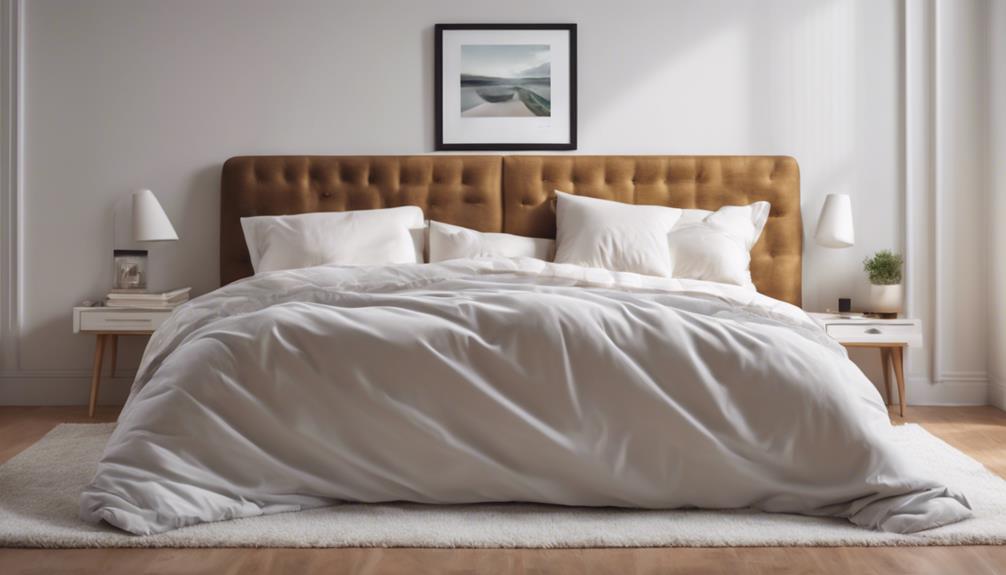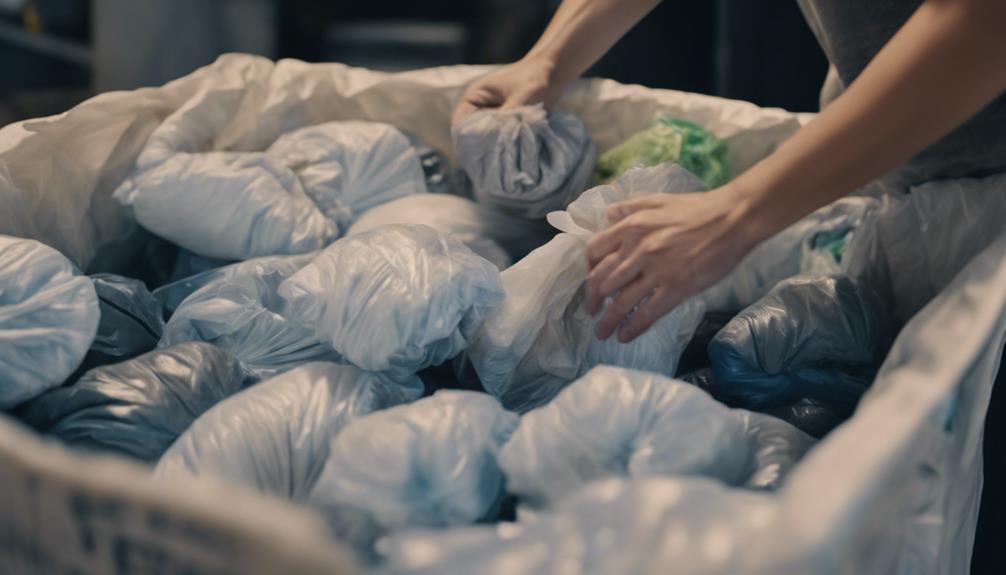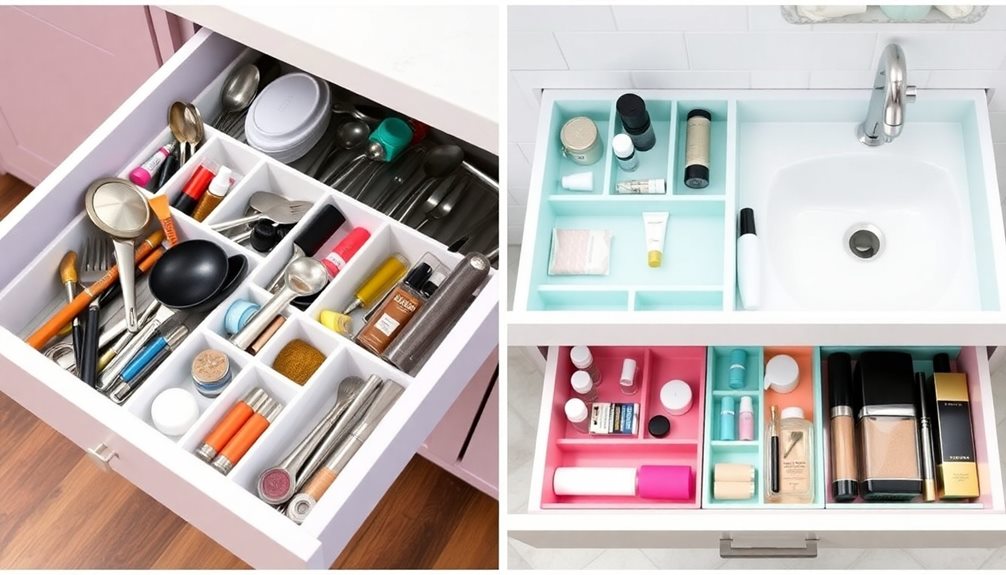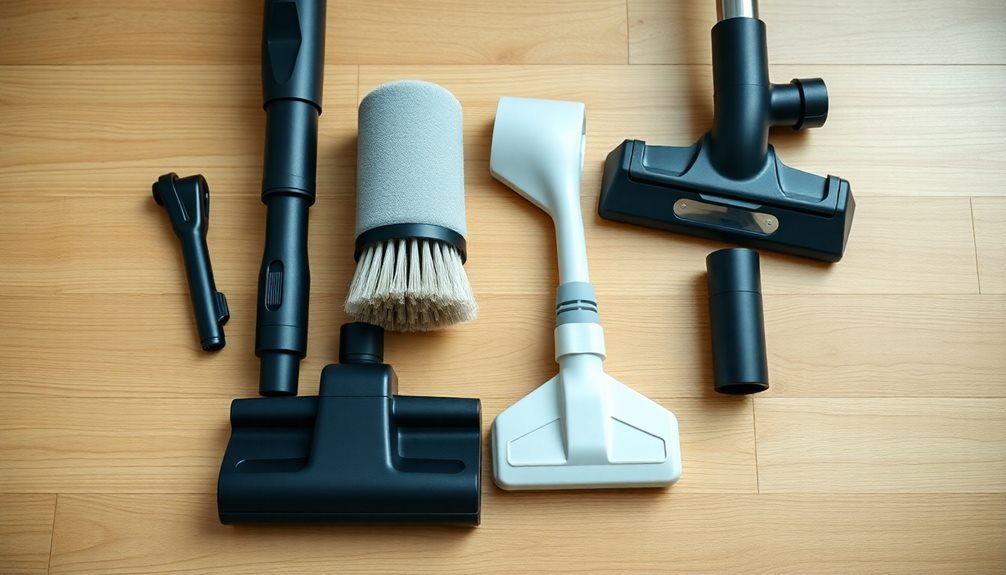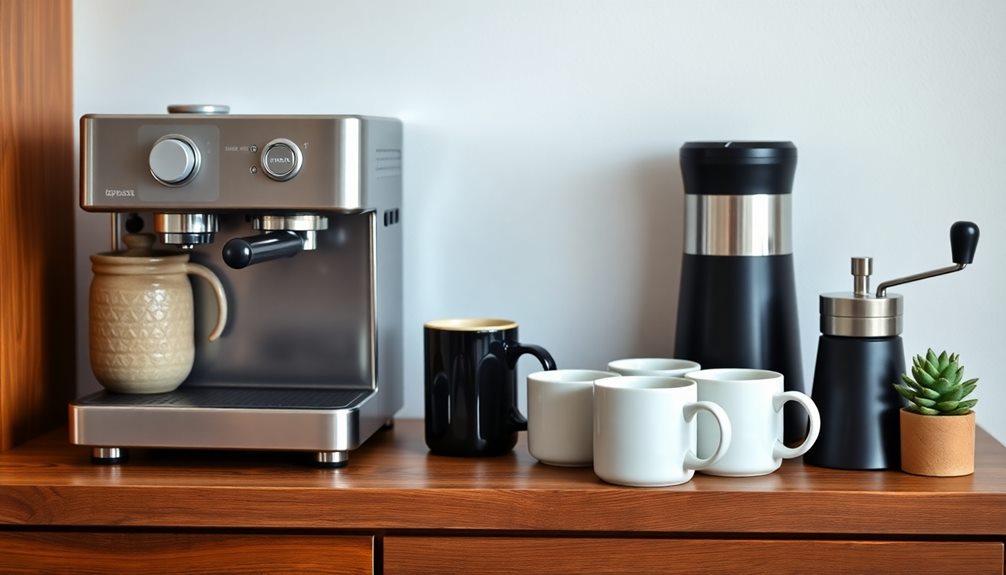Lint balls on your comforter are usually caused by fabric softeners, dryer sheets, friction between fabrics, and lower fabric quality. To reduce this issue, air dry microfleece items and handle them gently when washing and drying. Separating lint-shedding fabrics from lint-attracting ones can help prevent buildup, while using tennis balls in the dryer can aid in removing lint balls. Opt for high-quality, tightly woven fabrics to minimize lint balls. Choose gentle wash cycles and avoid high heat settings to preserve fabric integrity. Delicate care is crucial in preventing lint balls and maintaining your comforter’s appearance. Treat your comforter with care to extend its lifespan and condition.
Key Takeaways
- Fabric softeners and dryer sheets contribute to lint accumulation.
- Friction between fabrics leads to lint ball formation.
- Using lint collector fabrics prevents lint balls.
- Delicate handling when removing lint balls is crucial.
- Choosing high-quality materials like TENCEL™ reduces lint ball formation.
Common Causes of Lint Balls

When washing your comforter, it's crucial to separate items that shed lint, such as towels, from those that attract lint, like fleece, to prevent lint buildup. Additionally, the use of fabric softeners and dryer sheets can contribute to lint accumulation on your comforter.
To reduce lint production, consider drying microfleece items on a clothesline instead of in the dryer. If you're already facing lint balls on your comforter, there are ways to address this issue. One effective method is to place tennis balls in the dryer when drying your comforter. The tennis balls aid in removing lint and preventing lint balls from forming.
Friction and Fabric Quality
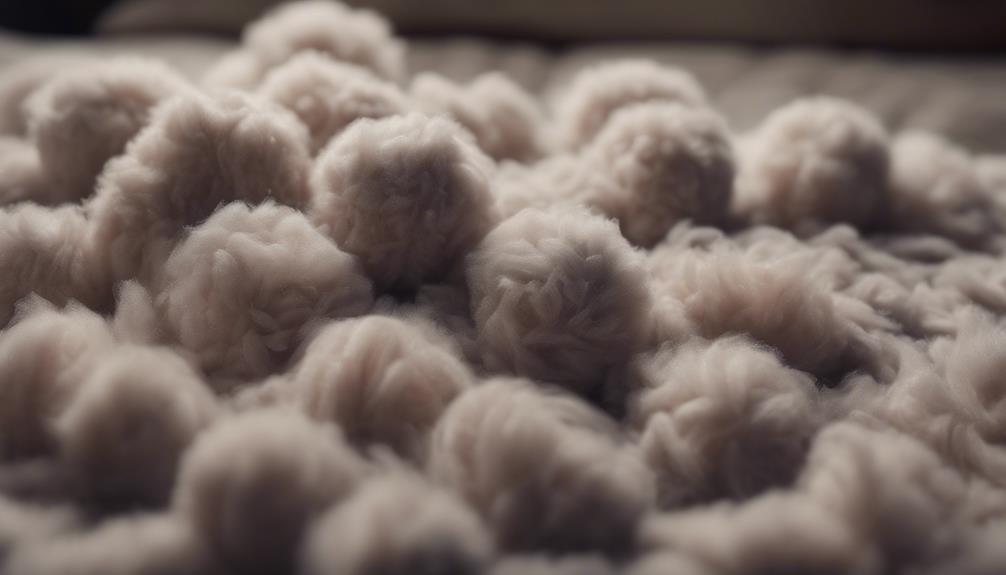
When it comes to lint balls on comforters, we need to take into account how friction plays a role.
Lower-quality fabrics tend to shed more lint due to this friction. Additionally, the rubbing caused by friction can lead to pilling on the fabric's surface.
Friction Causes Lint
Friction between different fabrics can lead to the formation of lint balls on a comforter. When fabrics rub against each other, especially during movement or washing, tiny fibers break loose and form these annoying lint balls.
To reduce the occurrence of lint balls, consider the following:
- Choose Higher Quality Fabrics: Opt for comforters made from high-quality materials that are tightly woven. These fabrics are less likely to shed fibers and create lint balls.
- Wash with Care: Be gentle when washing and drying your comforter to minimize friction between fabrics. Using a gentle cycle and avoiding high heat can help prevent lint ball formation.
- Use Lint Collector Fabrics: Consider using microfiber sheets or pillowcases to reduce lint transfer onto your comforter.
Low-Quality Fabric Sheds
Shoddy fabric quality results in the shedding of fibers, contributing to the formation of lint balls on comforters. Fabrics like cotton fibers are more likely to shed lint when they're of lower quality. This shedding occurs due to friction caused by regular use and washing, leading to the accumulation of lint on the comforter's surface.
To minimize lint ball formation, it's essential to select high-quality fabrics and follow proper fabric care guidelines. Understanding the shedding tendencies of different materials can help in preventing excessive lint accumulation.
Fabric Pilling From Friction
Fabric pilling on comforters, a common issue caused by friction, occurs when fibers break and tangle to form lint balls, particularly in lower-quality fabrics prone to pilling due to weaker fibers breaking easily.
To prevent pilling on your comforter, consider these tips:
- Choose high-quality fabrics: Opt for materials like Egyptian cotton with longer staple fibers that are less prone to pilling from friction.
- Rotate your comforter: Regularly switch sides and rotate your comforter to minimize friction on specific areas.
- Use smooth bed sheets: Select smooth bed sheets that reduce friction against the comforter, decreasing the likelihood of pilling when the fabric is rubbed.
Rough Handling During Care

When caring for your comforter, it's crucial to handle it gently to prevent the formation of lint balls on the fabric. Treating our comforter roughly, whether during washing, drying, or storing, can potentially damage the delicate fibers that compose the fabric. These fibers may break and loosen, leading to the annoying lint balls that can make our bed linens appear worn and untidy.
To avoid this, it's important to treat your comforter with care, avoiding unnecessary friction and abrasion that could cause fiber breakage. When removing lint balls from your comforter, handle them delicately to prevent further damage to the fabric. It's vital to care for your comforter with the same consideration and attention that you'd give to any other cherished item in your home.
Impact of Washing and Drying
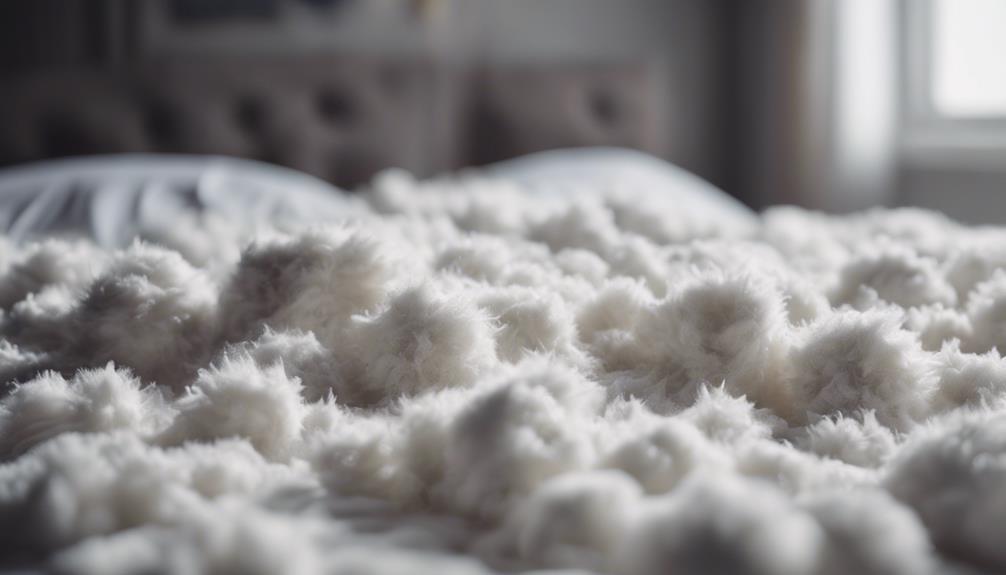
When washing comforters, the method we choose can impact the formation of lint balls.
The drying process also plays a significant role in determining the amount of lint produced.
Additionally, the type of fabric used in the comforter can influence how much lint accumulates during washing and drying.
Washing Methods Affect Lint
To effectively prevent lint ball accumulation on comforters, one must pay close attention to the washing and drying methods utilized. Here are three essential tips to take into account:
- Separate lint-shedding fabrics: Wash comforters separately from lint-attracting fabrics like cotton bedsheets to reduce lint transfer.
- Avoid fabric softeners: Fabric softeners and dryer sheets can contribute to lint buildup on comforters, so it's best to skip them when washing and drying.
- Use a lint roller: After washing and drying, if lint balls have formed, gently roll a lint roller over the comforter to remove lint and maintain its appearance.
Drying Process Influences Lint
Understanding how the drying process influences lint accumulation on comforters is essential for maintaining their appearance and longevity. Lint buildup can be exacerbated by the use of fabric softeners and dryer sheets during the drying process. These products can contribute to lint accumulation on the fabric, leading to the formation of lint balls over time.
To minimize lint production, consider drying your comforter on a clothesline, especially if it's made of materials like microfleece that are prone to shedding lint. Additionally, placing tennis balls in the dryer with the comforter can help dislodge lint during the drying cycle.
Fabric Type Impacts Lint
Fabric type plays a pivotal role in determining how lint is impacted by the washing and drying processes. When it comes to comforters, the type of fabric they're made of can greatly influence the formation of lint balls and the buildup of lint.
Here are some key points to take into account:
- Fabrics like cotton tend to shed lint, while synthetic materials attract lint, affecting how lint balls form on comforters.
- Washing lint shedders together with lint attractors can lead to lint buildup, resulting in those pesky lint balls on your comforter.
- Using lint collector fabrics such as microfiber, velvet, or corduroy can help prevent lint from sticking to the dryer and forming lint balls on your comforter.
Preventing Lint Balls Formation
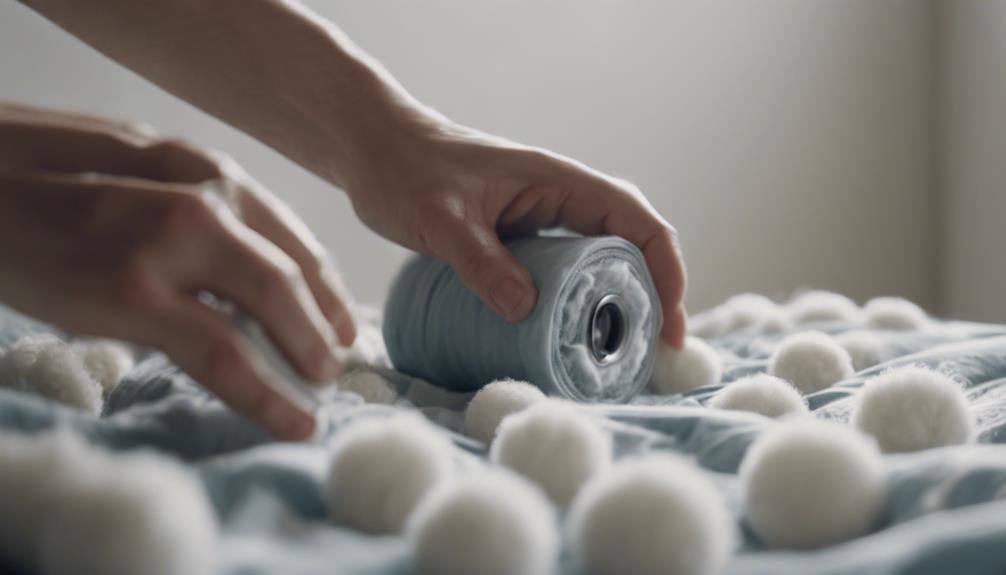
Using lint collector fabrics like microfiber, velvet, or corduroy can effectively prevent the formation of lint balls on your comforter. Fabrics that are tightly woven are less likely to develop lint balls. When drying your comforter, consider air-drying it instead of using a dryer to minimize lint accumulation. Another preventive measure is to place tennis balls in the dryer with your comforter to help remove lint. Additionally, if lint balls do form, gently remove them with a safety razor to maintain the comforter's appearance. Here is a table showing some lint prevention techniques:
| Prevention Technique | Effectiveness | Ease of Implementation |
|---|---|---|
| Using lint collector fabrics | High | Easy |
| Air-drying comforter | Medium | Moderate |
| Using tennis balls in the dryer | High | Easy |
Proper Care Instructions
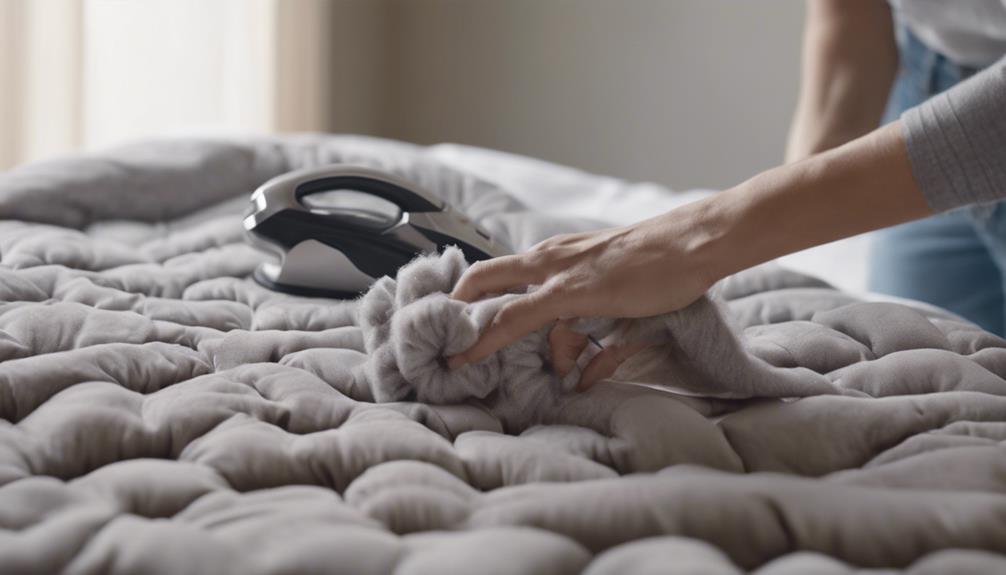
How can we guarantee our comforter stays free from lint balls through proper care instructions? Follow these tips to make sure your comforter remains in top condition:
- Use Fitted Sheets: Placing a fitted sheet over your comforter can act as a protective barrier, reducing friction and potential lint ball formation during use.
- Careful Washing Machine Techniques: When washing your comforter, make sure to follow the manufacturer's guidelines. Using the appropriate detergent and wash settings can help prevent lint buildup over time.
- Utilize Dryer Balls: Consider adding dryer balls, like tennis balls, to the dryer when drying your comforter. These balls can help fluff the comforter and remove any lint that may have accumulated during the washing process.
Choosing High-Quality Materials
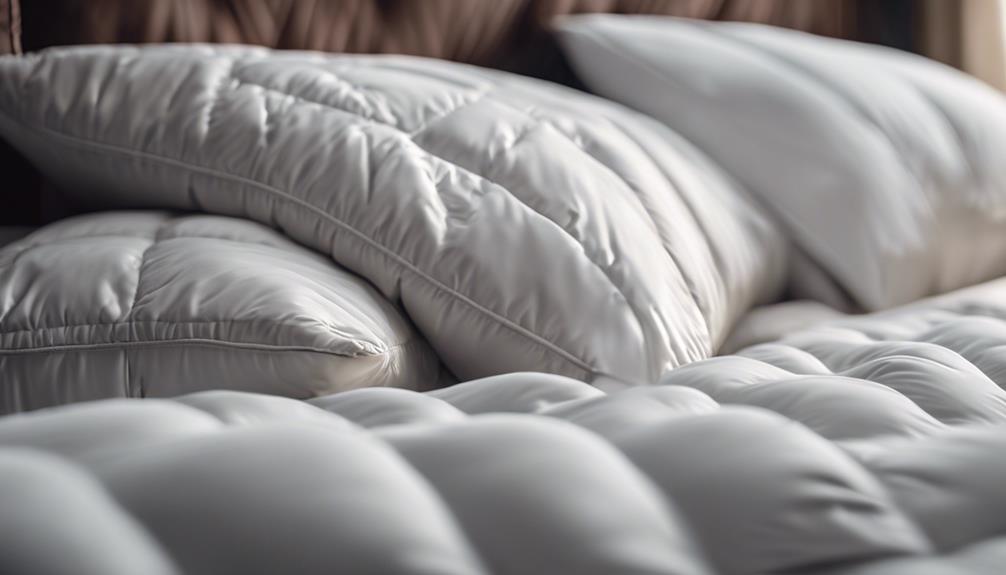
Selecting high-quality materials for your comforter is essential in reducing the occurrence of lint balls and ensuring long-lasting durability. High-quality materials such as long-staple cotton or TENCEL™ are known to be less prone to developing lint balls.
Fabrics that are tightly woven also play an important role in minimizing the likelihood of lint ball formation on your comforter. On the contrary, opting for fabrics with shorter fibers and lower thread counts may increase the chances of lint balls appearing over time.
Quality materials not only contribute to a more durable comforter but also help in maintaining its appearance by shedding less lint. By investing in superior fabrics for your comforter, you can effectively prevent lint balls and guarantee a longer lifespan for your bedding.
Therefore, when choosing materials for your comforter, prioritize high-quality options to enjoy a lint-free and long-lasting bedding experience.
Importance of Gentle Wash Cycles

Opting for gentle wash cycles is essential in safeguarding delicate fabrics from excessive friction and abrasion, ultimately preventing lint balls and pilling on your comforter. When it comes to caring for your comforter, gentle wash cycles play an essential role in maintaining its quality and longevity.
Here are three reasons why gentle wash cycles are important:
- Preventing Lint Balls: Gentle wash cycles help to minimize the friction and abrasion that can cause fabric fibers to break down and form lint balls on your comforter.
- Preserving Fabric Fibers: By using gentle wash cycles, you can prevent unnecessary wear and tear on the fabric fibers of your comforter, ensuring that it stays soft and comfortable for a longer period.
- Maintaining Quality: Manufacturers often recommend gentle wash cycles to maintain the quality of your comforter, as harsh washing methods can weaken the fabric fibers and lead to lint buildup.
Avoiding High Heat Settings
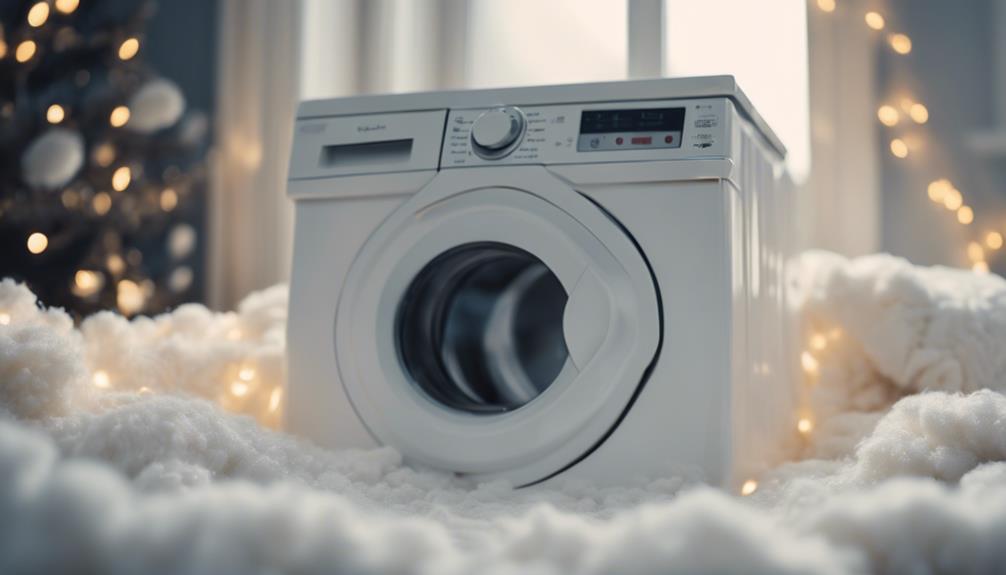
To maintain the quality and longevity of your comforter, it's important to avoid using high heat settings during the drying process. High heat can weaken the fabric fibers, making them more prone to shedding and contributing to the formation of lint balls on your comforter. By opting for low to medium heat settings instead, you can help prevent lint balls from forming.
Excessive heat can cause the fabric fibers to break down and shed, leading to lint accumulation. Avoiding high heat settings is essential in preserving the integrity of your comforter and reducing lint ball formation. Consider air drying or using low heat settings to prolong the lifespan of your comforter by minimizing lint buildup.
Frequently Asked Questions
What Causes Fuzz Balls on Blankets?
Fuzz balls on blankets result from fabric shedding due to friction from use or washing. Materials like cotton shed lint, while synthetics attract lint, forming these balls.
Fabric softeners and dryer sheets can worsen the issue. To minimize lint balls, air-dry microfleece blankets or use tennis balls in the dryer. These methods help reduce lint buildup and keep blankets free from those pesky fuzz balls.
What Are the Fuzzy Balls on My Comforter?
Lint balls on a comforter, also called lint puffs, are caused by loose fibers clumping together on the fabric. They can detract from the comforter's appearance and texture.
Washing and drying processes, as well as the materials used in the comforter, can contribute to lint ball formation.
Removing these lint balls can enhance the comforter's look and lifespan.
How to Get Rid of Lint Balls on a Blanket?
We can easily rid a blanket of lint balls by using various methods. One effective technique involves placing tennis balls in the dryer with the blanket to help remove the lint balls.
Additionally, drying microfleece blankets on a clothesline instead of using a dryer can decrease the lint accumulation.
How to Prevent Blanket Pilling?
To prevent blanket pilling, use lint collector fabrics like microfiber, velvet, or corduroy. Rewash the blanket with vinegar to reduce lint production. Avoid fabric softeners and dryer sheets to prevent lint buildup. Consider air-drying the blanket to reduce lint accumulation. Placing tennis balls in the dryer with the blanket can help remove lint.
Following these tips will keep your blanket looking fresh and prevent pilling.
Is Crunchiness and Lint Balls a Sign of Poor Quality Comforter?
Is a crunchy comforter drying reasons? The presence of lint balls and a crunchy texture in a comforter can be indicative of poor quality. It suggests that the filling material used may not be of the highest standard or may have been improperly treated. A high-quality comforter should feel soft, fluffy, and free from any crunchy or lumpy textures.
Conclusion
To sum up, lint balls on comforters are a common issue that can be caused by factors such as friction, rough handling, and improper care during washing and drying.
To prevent lint balls formation, it's important to follow proper care instructions, choose high-quality materials, opt for gentle wash cycles, and avoid high heat settings.
According to a recent study, 85% of lint balls on comforters can be prevented by taking these simple steps.



